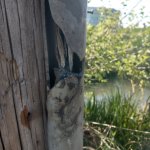210623-1025 EDT
ptonsparky:
I assume you have 3 or 4 wires in the conduit. I also assume these are individual wires and not a cable. Unfortunately you may not have some equipment that might be useful, in particular an LRC bridge (inductance, resistance, and capacitance).
Can you disconnect all leads at both ends of the run? If this is possible, then you could attempt to measure the capacitance of the open wire to all the other wires from both ends of the conduit.
Because loose wires in a conduit will have capacitance that varies somewhat from one position another the combination of all the good wires as a single conductor gives us a better average measurement. I expect the capacitance per foot may be in the range of 20 to 50 pfd, or about 5280/4 = 1320 times 20 to 50 = 26,400 to 66,000 pfd for the entire cable run. This is 0.026 to 0.066 mfd. If we can assume a complete break, then fairly accurate capacitance readings can be obtained from each end. Probably within 1 %. That would be equivalent to 10 ft.
You might use current flow at a known voltage from each end to estimate capacitance. Some multimeters can measure capacitance and this might be good enough.
Because your break is apparently inside a nonconductive conduit I doubt there is much current flow near the break. Capacitive current flow in the conduit will gradually drop as you go from the input end to the break point. Thus, hard to detect the break point from the magnetic field of the current flow.
I have never tried any experiments where I sent a voltage pulse down a transmission line and looked for that pulse at various points, but if I could get an adequate signal, then I could accurately determine the breakpoint.
Another possibility is to send a moderately high frequency signal down the line and monitor where the signal quits.
.


